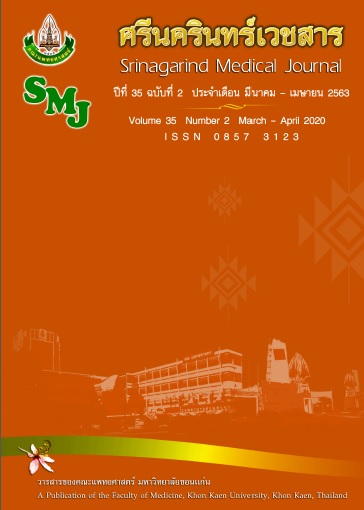Laparoscopic Versus Open Surgery in Children with Choledochal Cysts
Keywords:
ถุงน้ำดีโป่งพอง, การผ่าตัดผ่านกล้องในเด็ก, ประสบการณ์ต้น, choledochal cyst, Laparoscopic surgery in children, Early experienceAbstract
ผลการผ่าตัดโรคถุงน้ำดีโป่งพองในเด็กด้วยการผ่าตัดแบบผ่านกล้องและการผ่าตัดแบบเปิด
พัชรีภรณ์ ตันมิ่ง*, กนกรัตน์ ไทยวัชรามาศ, รัติติยาภรณ์ พันธ์เหนือ
หน่วยกุมารศัลยศาสตร์ ภาควิชาศัลยศาสตร์ คณะแพทยศาสตร์ มหาวิทยาลัยขอนแก่น
หลักการและวัตถุประสงค์: โรคถุงน้ำดีโป่งพองเป็นความผิดปกติที่พบได้ตั้งแต่แรกเกิด ซึ่งสามารถผ่าตัดรักษาได้ทั้งแบบผ่านกล้องและแบบเปิด ดังนั้นการศึกษานี้จึงมีวัตถุประสงค์เพื่อเปรียบเทียบผลของการรักษาด้วยการผ่าตัดทั้งสองแบบในโรงพยาบาลศรีนครินทร์
วิธีการศึกษา: เป็นการศึกษาจากเวชระเบียนผู้ป่วยโรคถุงน้ำดีโป่งพองที่อายุน้อยกว่า 18 ปี ที่เข้ารับการรักษาระหว่างเดือนมกราคม พ.ศ. 2557 ถึงเดือนพฤศจิกายน พ.ศ. 2562 โดยเก็บข้อมูลต่าง ๆ ของการผ่าตัดเพื่อเปรียบเทียบระหว่าง 2 กลุ่ม
ผลการศึกษา: ผู้ป่วยทั้งหมด 29 ราย มีผู้ป่วย 25 รายได้รับการผ่าตัดแบบเปิดและอีก 4 รายได้รับการผ่าตัดผ่านกล้อง พบว่าปัจจัยที่พบความแตกต่างทางสถิติ คือระยะเวลาการผ่าตัด โดยการผ่าตัดผ่านกล้องใช้เวลา 663.8 ± 67.5 นาที ส่วนการผ่าตัดแบบเปิดใช้เวลา 326.4 ±138.5 นาที ( p < 0.001) และขนาดของถุงน้ำ โดยกลุ่มที่ผ่าตัดผ่านกล้องมีขนาด 1.5 ซม. ซึ่งเล็กกว่าขนาดของกลุ่มที่ผ่าตัดแบบเปิดคือ 4.5 ซม. (p = 0.005) ในขณะที่ปัจจัยอื่น ๆ ที่ศึกษาไม่มีความแตกต่างกันในผู้ป่วยทั้งสองกลุ่ม
สรุป: การผ่าตัดผ่านกล้องเพื่อรักษาโรคถุงน้ำดีโป่งพองในเด็ก เป็นหัตถการที่สามารถทำได้ด้วยความปลอดภัย โดยไม่มีความแตกต่างของผลลัพธ์ในการรักษา รวมทั้งภาวะแทรกซ้อนเมื่อเปรียบเทียบกับการผ่าตัดแบบเปิด
Background and Objective: Choledochal cyst is an abnormal cystic dilatation of the biliary system. Many literature showed the laparoscopic surgery is a safe procedure when compared with open approach. The objective of this study was to compare the clinical safety of laparoscopic surgery with conventional open surgery in our hospital.
Methods: A retrospective study was conducted on all patients younger than 18 years who presented with a choledochal cyst in Srinagarind hospital from January 2014 to November 2019. The data were collected from medical records. The clinical safety defined as the operative time, intraoperative blood transfusion, blood loss, postoperative complication, time of first food intake and length of hospital stay. Data were compared between the 2 groups.
Results: A total of 29 patients were reviewed. 25 patients underwent open surgery, whereas 4 patients underwent laparoscopic reconstruction. Operative time and the cystic size had significant difference. The operative time in Laparoscopic group was 663.8 ±67.5 minutes and open group was 326.4 ± 138.5 minutes (p < 0.001). The cyst size in laparoscopic group was 1.5 cm. and in open surgery group was 4.5 cm. (p = 0.005). There were no significant difference among other factors of both groups.
Conclusions: Our initial experience indicates that the laparoscopic approach is safe and having no difference in the patient outcomes, including the complications when compared with the open operation.
References
Pediatric surgery. 7th. Coran. Elsevier Mosby; 2012.
Park SW, Koh H, Oh JT, Han SJ, Kim S. Relationship between anomalous pancreaticobiliary ductal union and pathologic inflammation of bile duct in choledochal cyst. Pediatr Gastroenterol Hepatol Nutr [Internet]. 2014; 17: 170–7. [cited Dec 3, 2019]. Available from: https://www.ncbi.nlm.nih.gov/pubmed/25349833
Yamataka A, Kato Y, Miyano T. Ashcraft’s Pediatric Surgery. 5th edition. Philadelphia: Elsevier ; 2010: 557–77.
Huang CS, Huang CC, Chen DF. Choledochal cysts: Differences between pediatric and adult patients. J Gastrointest Surg 2010; 14: 1105–10.
Shen HJ, Xu M, Zhu HY, Yang C, Li F, Li K wei, et al. Laparoscopic versus open surgery in children with choledochal cysts: a meta-analysis. Pediatr Surg Int 2015; 31: 529–34.
Liuming H, Hongwu Z, Gang L, Jun J, Wenying H, Wong KKY, et al. The effect of laparoscopic excision vs open excision in children with choledochal cyst: A midterm follow-up study. J Pediatr Surg [Internet]. 2011; 46: 662–5. [cited Dec 3,2019]. Available from: http://dx.doi.org/10.1016/j.jpedsurg.2010.10.012
Liuming H, Hongwu Z, Gang L, Jun J, Wenying H, Wong KKY, et al. The effect of laparoscopic excision vs open excision in children with choledochal cyst: A midterm follow-up study. J Pediatr Surg [Internet]. 2011; 46: 662–5. [cited Dec 3, 2019] Available from: http://dx.doi.org/10.1016/j.jpedsurg.2010.10.012
Liem NT, Pham HD, Dung LA, Son TN, Vu HM. Early and intermediate outcomes of laparoscopic surgery for choledochal cysts with 400 patients. J Laparoendosc Adv Surg Tech [Internet]. 2012; 22: 599–603. [cited Dec 3, 2019]. Available from: http://www.ncbi.nlm.nih.gov/pubmed/22691183
She WH, Chung HY, Lan LCL, Wong KKY, Saing H, Tam PKH. Management of choledochal cyst: 30 years of experience and results in a single center. J Pediatr Surg [Internet]. 2009; 44: 2307–11. [cited Dec 3,2019]. Available from: https://www.clinicalkey.com/#!/content/playContent/1-s2.0-S0022346809006265?returnurl=https:%2F%2Flinkinghub.elsevier.com%2Fretrieve%2Fpii%2FS0022346809006265%3Fshowall%3Dtrue&referrer=https:%2F%2Fwww.ncbi.nlm.nih.gov%2F
Aspelund G, Ling SC, Ng V, Kim PCW. A role for laparoscopic approach in the treatment of biliary atresia and choledochal cysts. [cited Dec 16, 2019]; Available from: www.elsevier.com/locate/jpedsurg


